Samenvatting
Technology refers to any set of standardised procedures for transforming raw materials into finished products. Innovation consists of any change in technology which has tangible and lasting effect on human practices, whether or not it provides utilitarian advantages. Prehistoric societies were never static, but the tempo of innovation occasionally increased to the point that we can refer to transformation taking place. Prehistorians must therefore identify factors promoting or hindering innovation.
This volume stems from an international workshop, organised by the Collaborative Research Centre 1266 'Scales of Transformation' at Kiel University in November 2017. The meeting challenged its participants to detect and explain technological change in the past and its role in transformation processes, using archaeological and ethnographic case studies. The papers draw mainly on examples from prehistoric Europe, but case-studies from Iran, the Indus Valley, and contemporary central America are also included. The authors adopt several perspectives, including cultural-historical, economic, environmental, demographic, functional, and agent-based approaches.
These case studies often rely on interdisciplinary research, whereby field archaeology, archaeometric analysis, experimental archaeology and ethnographic research are used together to observe and explain innovations and changes in the artisan's repertoire. The results demonstrate that interdisciplinary research is becoming essential to understanding transformation phenomena in prehistoric archaeology, superseding typo-chronological description and comparison.
This book is a scholarly publication aimed at academic researchers, particularly archaeologists and archaeological scientists working on ceramics, osseous and metal artefacts.
Contents
Preface
Michela Spataro
Introduction
Michela Spataro and Martin Furholt
Understanding the acceptance of innovative technical skills across time. Ethnographic and theoretical insights from Latin America
Dean E. Arnold
Innovation or inheritance? Assessing the social mechanisms underlying ceramic technological change in early Neolithic pottery assemblages in Central Europe
Louise Gomart, Alexandra Anders, Attila Kreiter, Tibor Marton, Krisztián Oross and Pál Raczky
Changes in the pottery production of the Linear Pottery Culture. Origins and directions of ideas
Anna Rauba-Bukowska and Agnieszka Czekaj-Zastawny
Innovations in ceramic technology in the context of culture change north of the Carpathians at the turn of the 6th and 5th millennia BC
Sławomir Kadrow
Neolithic pottery innovation in context. A model and case study from the Central and Western Balkans
Robert Hofmann
Technological innovation and social change. Early vs. late Neolithic pottery production of the Central Balkans
Jasna Vuković
Technological changes and innovations in the osseous industries in the early and late Neolithic in the Balkans
Selena Vitezović
Early wheel-made pottery in the Carpathian Basin
Szabolcs Czifra, Éva Kovács-Széles, Orsolya Viktorik, Péter Pánczél and Attila Kreiter
The onset of wheel-throwing in Middle Asia. A neolithic innovation?
Massimo Vidale
Technological Innovation. Defining terms and examining process through the talc-faience complex in the Indus Civilization
Heather Margaret-Louise Miller
Skill in high-temperature crafts. An artisanal perspective on fire
Katarina Botwid




